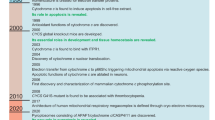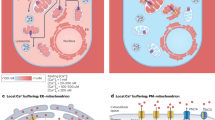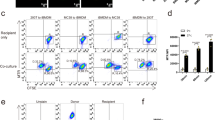Abstract
Release of apoptogenic factors into the cytosol including cytochrome c is triggering the execution phase of apoptosis through activation of cytoplasmic effector caspases. How loss of function of the electron transport chain can be reconciled with an adequate energy supply necessary for executing the apoptotic program was studied in granulosa cell (GC) sheets cultured up to 72 h without gonadotrophic support. Cytochrome c was localized ultrastructurally by oxidation of diaminobenzidine tetrahydrochloride both in living and fixed cells. In uncultured GC sheets all cells show staining over their entire mitochondrial population. In 72 h cultured sheets in the absence of FSH pre-apoptotic GC's display two subsets of mitochondria: normal sized stained mitochondria and small orthodox mitochondria without demonstrable cytochrome function. Apoptotic cells contain several mitochondria with preservation of respiratory function besides unstained orthodox mitochondria. The cytochrome c containing mitochondria typically display dilated intracristal spaces, a mitochondrial conformation related to increased ATP production. Cytochrome c release was confirmed by Western blotting. In 72 h cultures supplemented with FSH, GC's displayed staining over their entire mitochondrial population. In cultures lacking FSH, but partially protected from apoptosis through caspase inhibition, the cytochrome c release was not inhibited. Thus in the present studied model dysfunction of only a subset of mitochondria is instrumental to initiate the apoptotic program while a functional electron transport chain is maintained until the degradation phase in a subset of respiring mitochondria.
Similar content being viewed by others
Log in or create a free account to read this content
Gain free access to this article, as well as selected content from this journal and more on nature.com
or
Abbreviations
- AI:
-
apoptotic index
- DAB:
-
diaminobenzidine tetrahydrochloride dihydrate
- FSH:
-
follicle stimulating hormone
- GC:
-
granulosa cell
- zVAD-fmk:
-
Z-Val-Ala-Asp-fluoromethylketone
References
Kerr JF and Harmon BV . (1991) Definition and incidence of apoptosis: A historical perspective. In: Current Communications in Cell and Molecular Biology. Apoptosis: The molecular basis of cell death,Tomei LD and Cope FO, eds. vol. 3 (Cold Spring Harbor: Laboratory Press) pp5–29
Hockenbery D, Nunez G, Milliman C, Schreiber R and Korsmeyer S . (1990) Bcl-2 is an inner mitochondrial membrane protein that blocks programmed cell death. Nature 348: 334–336
Newmeyer DD, Farschon DM and Reed JC . (1994) Cell-free apoptosis in Xenopus egg extracts: inhibition by Bcl-2 and requirement for an organelle fraction enriched in mitochondria. Cell 79: 353–364
Lazebnik YA, Cole S, Cooke CA, Nelson WG and Earnshaw WC . (1993) Nuclear events of apoptosis in vitro in cell-free mitotic extracts: A model system for analysis of the active phase of apoptosis. J. Cell Biol. 123: 7–22
Richter C, Schweizer M, Cossarizza A and Franceshi C . (1996) Control of apoptosis by cellular levels of ATP. FEBS Lett. 378: 107–110
Tsujimoto Y . (1997) Apoptosis and necrosis: Intracellular ATP level as a determinant for cell death modes. Cell Death Differ. 4: 429–434
Nicotera P and Leist M . (1997) Energy supply and the shape of death in neurons and lymphoid cells. Cell Death Differ. 4: 435–442
Kroemer G . (1997) Mitochondrial implication in apoptosis. Towards an endosymbiont hypothesis of apoptosis evolution. Cell Death Differ. 4: 443–456
Liu X, Kim CN, Yang J, Jemmerson R and Wang X . (1996) Induction of apoptotic program in cell-free extracts: Requirement for dATP and cytochromec. Cell 86: 147–157
Green DR and Reed JC . (1998) Mitochondria and apoptosis. Science 281: 1309–1312
Murphy AN . (1999) Potential mechanisms of mitochondrial cytochrome-c release during apoptosis. Drug Develop. Res. 46: 18–25
Kluck RM, Bossy-Wetzel E, Green DR and Newmeyer DD . (1997) The release of cytochromec from mitochondria: A primary site for Bcl-2 regulation of apoptosis. Science 275: 1132–1136
Yang J, Liu X, Bhalla K, Kim CN, Ibrado AM, Cai J, Peng TI, Jones DP and Wang X . (1997) Prevention of apoptosis by Bcl-2: release of cytochromec from mitochondria blocked. Science 275: 1129–1132
Rossé T, Olivier R, Monney L, Rager M, Conus S, Fellay I, Jansen B and Borner C . (1998) Bcl-2 prolongs cell survival after Bax-induced release of cytochromec. Nature 391: 496–499
D'Herde K and Leybaert L . (1997) Intracellular free calcium related to apoptotic cell death in quail granulosa cell sheets kept in serum-free culture. Cell Death Differ. 4: 59–65
D'Herde K and Leybaert L . (1998) Apoptotic granulosa cells have moderately increased intracellular free calcium during phosphatidylserine exposure and a normal resting calcium level during DNA fragmentation. Apoptosis 3: 337–343
Zhuang J, Dinsdale D and Cohen GM . (1998) Apoptosis, in human monocytiic THP.1 cells, results in the release of cytochromec prior to their ultracondensation, formation of outer membrane discontinuities and reduction in inner membrane potential. Cell Death Differ. 5: 953–962
Orrenius S, Burgess DH, Hampton MB and Zhivotovsky B . (1997) Mitochondria as the focus of apoptosis research. Cell Death Differ. 4: 427–428
Reed JC . (1997) Cytochromec: Can't live with it–can't live without it. Cell 91: 559–562
Smiley ST, Reers M, Mottola-Harshorn C, Lin M, Chen A, Smith TW, Steele Jr GD and Chen LB . (1991) Intracellular heterogeneity in mitochondrial membrane potentials revealed by a J-aggregate-forming lipophilic cation. Proc. Natl. Acad. Sci. USA 88: 3671–3675
Camilleri-Bröet S, Vanderwerff H, Caldwell E and Hockenbery D . (1998) Distinct alterations in mitochondrial mass and function characterize different models of apoptosis. Exp. Cell Res. 239: 277–292
Bradham CA, Qian T, Streetz K, Trautwein C, Brenner DA, Lemasters JJ . (1998) The mitochondrial permeability transition is required for tumor necrosis factor alpha-mediated apoptosis and cytochromec release. Mol. Cell. Biol. 18: 6353–6364
Diaz G, Setzu MD, Zucca A, Isola R, Diana A, Murru R, Sogos V and Gremo F . (1999) Subcellular heterogeneity of mitochondrial membrane potential: relationship with organelle distribution and intercellular contacts in normal, hypoxic and apoptotic cells. J. Cell Sci. 112: 1077–1084
Li F, Srinivasan A, Wang Y, Armstrong RC, Tomaselli KJ and Fritz LC . (1997) Cell-specific induction of apoptosis by microinjection. J. Biol. Chem. 272: 30299–30305
Zhivotovsky B, Orrenius S, Brustugun OT and Doskeland SO . (1998) Injected cytochromec induces apoptosis. Nature 391: 449–450
Bossy-Wetzel E, Newmeyer D and Green D . (1998) Mitochondrial cytochromec release in apoptosis occurs upstream of DEVD-specific caspase activation and independently of mitochondrial transmembrane depolarization. EMBO J. 17: 37–49
Neame SJ, Rubin LL and Philpott KL . (1998) Blocking cytochromec activity within intact neurons inhibits apoptosis. J. Cell Biol. 142: 1583–1593
Andreyev AY, Fahy B and Fiskum G . (1998) Cytochromec release from brain mitochondria is independent of the mitochondrial permeability transition. FEBS Lett. 439: 373–376
Manaon S, Chaudhuri B and Guérin M . (1997) Release of cytochromec and decrease of cytochromec oxidase in Bax-expressing yeast cells, and prevention of these effects by coexpression of Bcl-XL. FEBS Lett. 415: 29–32
Krippner A, Matsumo-Yagi A, Gottlieb RA and Babior BM . (1996) Loss of function of cytochromec in jurkat cells undergoing fas-mediated apoptosis. J. Biol. Chem. 271: 21629–21636
Angermüller S, Künstle G and Tiegs G . (1998) Pre-apoptotic alterations in hepatocytes of TNF-a treated galactosamine-sensitized mice. J. Histochem. Cytochem. 46: 1175–1183
Mancini M, Anderson BO, Caldwell E, Sedginasab M, Paty PB and Hochenbery DM . (1997) Mitochondrial proliferation and paradoxical membrane depolarization during terminal differentiation and apoptosis in a human colon carcinoma cell line. J. Cell Biol. 138: 449–469
Hackenbrock CR . (1968) Ultrastructural bases for metabolically linked mechanical activity in mitochondria. II. Electron transport-linked ultrastructural transformation in mitochondria. J. Cell Biol. 37: 345–369
Hackenbrock CR, Rehn TG, Weinbach EC and Lemasters JJ . (1971) Oxidative phosphorylation and ultrastructural transformation in mitochondria in the intact ascites tumor cell. J. Cell Biol. 51: 123–131
Martinou I, Desagher S, Eskes R, Antonsson B, André E, Fakan S and Matinou JC . (1999) The release of cytochromec from mitochondria during apoptosis of NGF-deprived sympathetic neurons in a reversible event. J. Cell Biol. 144: 883–889
Vander Heiden MG, Chandel NS, Williamson EK, Schumacker PT and Thompson CB . (1997) Bcl-Xl regulates the membrane potential and volume homeostasis of mitochondria. Cell 91: 627–637
Borner C and Monney L . (1999) Apoptosis without caspases: an inefficient molecular guillotine? Cell Death Differ. 6: 497–507
Schotte P, Declercq W, Van Huffel S, Vandenabeele P and Beyaert R . (1999) Non-specific effects of methyl ketone peptide inhibitors of Caspases. FEBS Lett. 442: 117–121
Gilbert AB, Evans AJ, Perry MM and Davidson MH . (1977) A method for separating the granulosa cells, the basal lamina and the theca of the preovulatory ovarian follicle of the domestic fowl (Gallus domesticusf). J. Reprod. Fertil. 50: 179–181
Tilly JL and Tilly KI . (1995) Inhibitors of oxidative stress mimic the ability of follicle-stimulating hormone to suppress apoptosis in cultured rat ovarian follicles. Endocrinol. 136: 242–252
Roels F . (1974) Cytochromec and cytochrome oxidase in diaminobenzidine staining of mitochondria. J. Histochem. Cytochem. 22: 442–444
DiMauro S, Servidei S, Zeviani M, Di Rocco M, De Vivo DE, Didonato S, Uziel G, Berry K, Hoganson G and Johnsen SD . (1987) Cytochromec oxidase deficiency in Leigh syndrome. Ann. Neurol. 22: 498–506
Seligman AM, Karnovsky MJ, Wasserkrug HL and Hanker JS . (1968) Non droplet ultrastructural demonstration of cytochrome oxidase activity with a polymerizing osmiophilicreagent, diaminobenzidine (DAB). J. Cell Biol. 38: 1–13
Acknowledgements
The authors are indebted to N Verweire and D Jacobus for excellent technical assistance. This study was supported by the BOF (Bijzonder Onderzoeksfonds) to K D'Herde 01115099. P Schotte and R Beyaert are researchers with the IWT and FWO-Vlaanderen, respectively.
Author information
Authors and Affiliations
Corresponding author
Additional information
Edited by JC Reed
Rights and permissions
About this article
Cite this article
D'Herde, K., De Prest, B., Mussche, S. et al. Ultrastructural localization of cytochrome c in apoptosis demonstrates mitochondrial heterogeneity. Cell Death Differ 7, 331–337 (2000). https://doi.org/10.1038/sj.cdd.4400655
Received:
Revised:
Accepted:
Published:
Issue date:
DOI: https://doi.org/10.1038/sj.cdd.4400655
Keywords
This article is cited by
-
Phosphorylation disrupts long-distance electron transport in cytochrome c
Nature Communications (2022)
-
The virulent Wolbachia strain wMelPop increases the frequency of apoptosis in the female germline cells of Drosophila melanogaster
BMC Microbiology (2012)
-
Life and death of female gametes during oogenesis and folliculogenesis
Apoptosis (2008)
-
Gap junctions and the propagation of cell survival and cell death signals
Apoptosis (2005)
-
Proteins That Fuse and Fragment Mitochondria in Apoptosis: Con-Fissing a Deadly Con-Fusion?
Journal of Bioenergetics and Biomembranes (2005)



